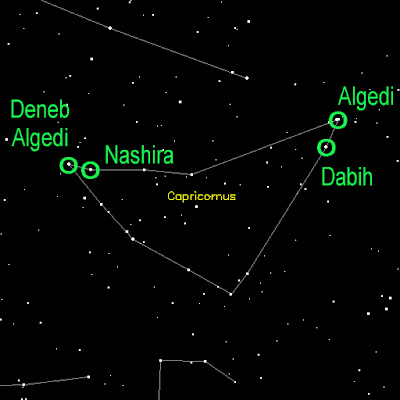This time, let’s take a look at the more prominent stars of the Bandanna— the ones with traditional names. They all lie along the top of the Bandanna. If you need help locating Capricornus, review my previous post.
The top left corner of the Bandanna is marked by Deneb Algedi, from the Arabic for tail of the goat. Deneb Algedi (DENN-ebb uhl-JEDD-ee), the brightest star in Capricornus, is a white star that lies about 39 light years away. A light year is the distance light travels in one Earth year, nearly six trillion miles.

Moving right (or west), the next bright star is Nashira (nah-SHEE-rah). Its precise meaning in Arabic is unclear, but it references “luck.” Nashira is also a white star, but it lies nearly 100 light years farther away than Deneb Algedi.
Traveling across the top of the Bandanna toward the upper right corner, we next come to Dabih. Dabih (DAH-bee) is from the Arabic for luck of the slaughterer, a reference to the seasonal sacrifice made by Arabs when Dabih first appeared in the dawn sky before sunrise. Dabih is a binary system, that is, two stars in orbit around one another. The brighter of the pair is an orange giant, and the companion star is a blue-white giant. You should be able to “split” Dabih, that is, separate the two component stars, using binoculars.
The upper right corner of the Bandanna is marked by Algedi, Arabic for goat. Algedi is also two stars, but unlike Dabih, the two components are not gravitationally associated. They simply appear close together by line of sight from Earth. This type of double star is called an optical double. Coincidentally, both components of Algedi are yellow stars, similar in temperature to our Sun.
If you have keen eyesight, you should be able to split Algedi with the naked eye. If this proves difficult, the magnification provided by a pair of binoculars will bring you certain success.

Astronomy Essential: Constellations are three-dimensional.
We experience the night sky as if it’s an upside-down bowl, painted black, with an artistic sprinkle of luminous white dots. In other words, we experience it as a two-dimensional plane.
The connect-the-dot star pictures of the ancients, persisting across the centuries, do nothing to disabuse us of this notion.
We stargazers must, therefore, make a conscious effort to remember that the constellations and asterisms we use to navigate the sky are three-dimensional. Although we perceive a particular star pattern in two dimensions, the stars of that pattern are distributed in three dimensions. Some of the stars are relatively close to us, and some are relatively far from us.
If we could fly out into space and “through” a particular constellation, we would experience this first-hand. Zipping past each star in turn, we would finally see the third dimension— the depth— of space. We would finally understand that constellations and asterisms and any other patterns our brain seeks to make from random star positions are simply the artificial constructs of Earth-bound life forms with active imaginations.